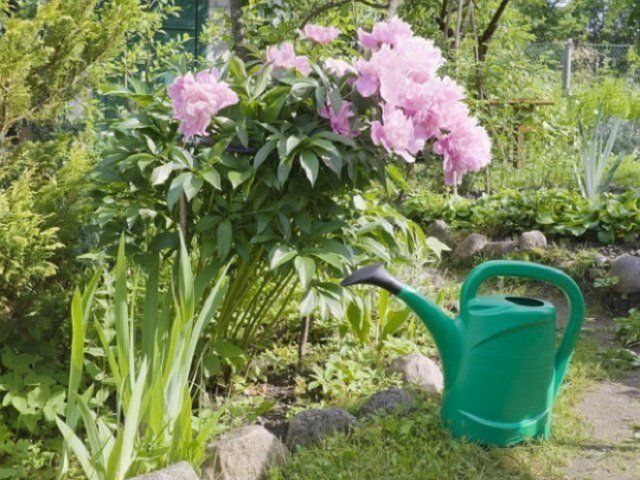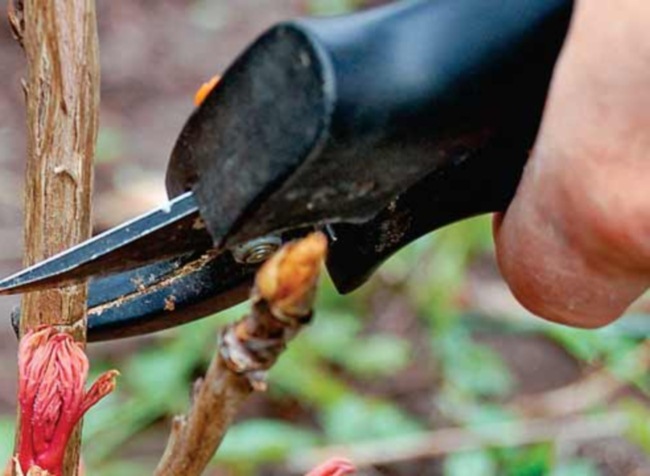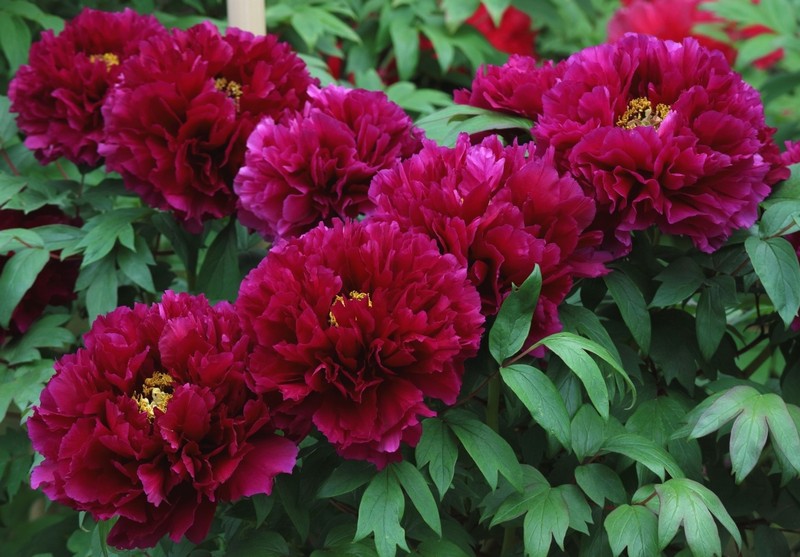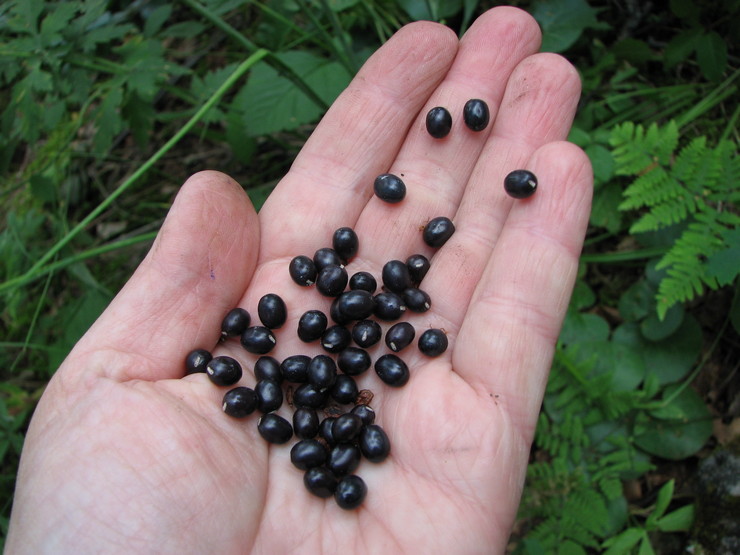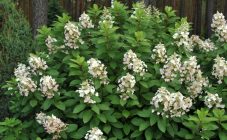Content:
Peonies are a beautiful perennial flower that grows in many summer cottages. The plant is unpretentious, with proper care it will grow for a long period of time and bloom with large fragrant flowers.
How to care for peonies in spring
With the onset of the first sunny spring days, the flower begins to awaken after winter. Young shoots begin to swell near the bushes.
After the snow melts, flowers need to be looked after. In the spring, as the soil dries out, the soil must be regularly moistened. Do not allow the soil to dry out and form a crust on the ground.
Recommendations for watering, caring for peonies in the spring in the garden:
- Watering can be infrequent, but abundant. 3-4 watering is enough for the whole season;
- One bush, depending on the size, will require 2-5 buckets of water;
- Watering is best early in the morning or in the evening, after sunset;
- For the water to saturate the ground, holes must be made around the bushes;
- Watering is completed in August, after the flowering period.
Periods when the bushes are necessarily watered:
- With swelling of the kidneys in the spring;
- When budding;
- After the withering of the flowers;
- In hot weather in August.
To get enough oxygen into the soil, it is necessary to loosen the soil. Loosening is carried out after each watering or rain. The soil is plowed carefully, the distance from the bush should be at least 20 cm. The gardening tool should be buried to a depth of 5 cm. When loosening, it is useful to immediately remove the weeds by hand.
For the active growth of the plant, it is advisable to fertilize and feed the soil. Types of dressings with which you can fertilize peonies:
- Preventive feeding. After the snow melts, holes with flowers are poured with a solution of potassium permanganate (2 g of manganese per bucket of water). This procedure is a prophylaxis against fungal diseases;
- Nitrogen-potassium. During the swelling of the shoots, at the end of March, the soil is fertilized with rotted manure (5 liters per bush) or nitrogen-potassium fertilizer (20 g), evenly distributing it over the surface of the hole. Retreat 15-20 cm from the bush. After applying organic matter or mineral fertilizer, the earth is dug to a depth of 10 cm, then covered with a compost layer of 4 cm and watered with water;
- Complex feeding. Approximately 20 days after nitrogen-potassium fertilization, the soil can be fertilized with complex mineral fertilizers. It is necessary to mix nitrogen (10 g), potassium (20 g), superphosphate (30 g), dilute them in a bucket of water and water the bush. From a lack of potassium and phosphorus, flowering will not be active.
Taking care of mature bushes is not difficult. The gardener will need to perform standard agrotechnical manipulations and know how to feed the peonies during flowering.
Leaving after flowering in summer
Peonies differ in color of buds, beginning and duration of flowering. Some varieties begin to bloom in early May.
At the end of June, by the beginning of July, the flowers wilted. If you cut off the side buds during flowering, then the central one will turn out to be large. By pruning a withering main flower, the lateral flowers can be extended to bloom.
As soon as the plant has completely faded, the wilted buds are cut off.
How to cut peonies for a bouquet
Garden lily, chrysanthemums, peonies grow in every country house.One cannot help but love bright and fragrant flowers, from which you can assemble a bouquet and put in a vase.
In order for the bush to continue to develop normally after pruning the buds, you need to know a few rules on how to cut flowers:
- At least 2-3 leaves should remain on the stem from which the peony is cut;
- The lateral buds are cut first, so the bush will grow more magnificently;
- You can cut flowers in the third year of the bush's life.
If you follow some simple tips, you can collect a large bouquet of beautiful peonies every year, without harming the main bush.
Pruning peonies
After all the buds have wilted, the bush needs preventive pruning. Peonies begin to bloom by the end of June.
A month after flowering, buds begin to form and develop. With proper care, the bush will be healthy and beautiful.
Withered heads must be trimmed to the first leaf. This procedure allows you to increase the frost resistance of the plant, prevents the appearance of gray rot.
If the variety grows very large flowers, and they bend over the stems of the bush, then it is necessary to establish a support around the plant. If there are a lot of flowers, then you can cut off some. It is better if the buds are cut with a garden tool.
Top dressing
If the soil is fertilized in a timely manner and dosed, then the peony bushes will be lush and healthy. Feeding peonies allows you to accelerate the growth of the root system, is responsible for the formation of buds, and increases the plant's immunity to various diseases. Top dressing of peonies in spring and summer is responsible for flowering activity.
Organic fertilizers alternate with mineral fertilizers. It is important to consider the recommended dosage so as not to burn the bush.
As additives, how to feed peonies, use mineral and organic fertilizers:
- Ammonium nitrate (15 g per bush);
- Superphosphate (10 g per bush);
- Potassium preparations (5 g per bush);
- Rotten manure;
- Compost.
Peony care in autumn
In August, they stop watering the peony bushes, cut off the wilted parts of the plant. In the fall, bushes in the country can be planted or transplanted. When transplanting to a new location, the site must be prepared.
If it is not planned to carry out manipulations of planting bushes in a new place, digging them up for planting, then all care for peonies consists in cutting off withered stems and foliage. It is advisable to burn the cut parts of the plant in order to destroy the pests that could appear there.
The rest of the bush is sprinkled with ash: 2-3 handfuls per adult bush.
When to prune peonies for the winter
They begin to cut the bushes after the onset of the first frost. In the suburbs and central Russia, this is mid-September. The bush must be trimmed so that the stems are 1-3 cm long.
The cut stems are burned to destroy pests, pathogenic microorganisms. The bushes are sprinkled with ash on top. A bush will need 100-200 g of ash.
The leaves can be pink, red, bronze or yellow. If you cut the leaves ahead of time before the onset of cold weather, you can harm the bush.
If pruning is planned earlier (July-end of August), then it is necessary to leave 3-4 leaves on each stem on the bush.
Preparing peonies for winter
Peonies are hardy plants. Even in harsh winters, flowers do not freeze. They tolerate cold days well in the Urals and Siberia.
Before the onset of winter, check the soil layer that covers the root. If the layer of earth is small, then the hole is additionally earthed up and sprinkled with earth.
It is undesirable to take manure, foliage, sawdust as a mulch layer. They can cause the spread of fungal diseases. For the normal growth of the bush, it is important to consider what fertilizer can be used for the peonies.
Shelter peonies for the winter
Mature bushes do not need additional shelter or digging up for the winter. It is important to properly care for the bush during the flowering period and carry out the subsequent pruning of the stems. If the bush is healthy, then it will tolerate frosty days well.
A small shelter of mulch should be made only for young or transplanted peonies. Their root system is not yet sufficiently developed, but a layer of peat will help save the plant from cold weather.
Herbaceous and tree peonies
The easiest way to breed peonies is to divide the bush. It is allowed to divide the bushes at the age of at least 3 years. When dividing, young bushes can begin to wilt, so it is undesirable to disturb them for the first two years.
The optimal time for breeding is the beginning of autumn. In September, the sun is no longer active, the days are not hot. Plus, during this period, the rainy season begins, so the earth will be sufficiently moistened, and the roots will quickly take root in a new place.
Instructions for reproduction by dividing the bush:
- Dig out the rhizome and carefully cut it into pieces with a sharp knife;
- Each cut should have 3-4 healthy buds and good roots;
- If there are damaged roots, then they must be removed;
- The planting material must be disinfected in a weak solution of potassium permanganate. The roots are placed in the solution for 2 hours. This is a prevention against root rot;
- Places of cuts must be sprinkled with coal or wood ash;
- After all the procedures, the roots are placed in a dark place so that they dry out a little;
- After that, you can plant peonies in a prepared place.
Sometimes a seed propagation method is used. But this method is used mainly by breeders to develop new varieties. This process is laborious and time consuming. The first flowering occurs only 5 years after planting.
Diseases and pests
Peony bushes under the influence of various factors can be affected by diseases and pests. Diseases of peonies:
- Gray rot. A type of fungal disease that affects stems, leaves and buds. The cause of gray mold is excessive humidity. On the leaves and stem, you can notice the appearance of unhealthy spots with a gray tint. The infected parts of the plant are cut and burned. Copper sulfate (4 g per 1 sq. M), iodine solution (1.5 ml per 600 ml of water), infusion of onion husks (20 g per 1 l of water) are used as prevention and control;
- Brown spots. With a lack of phosphorus, brown spots begin to form on the leaves. Since a bush can grow in one place for more than 20 years, the land is often depleted, and even with regular feeding, an insufficient amount of minerals is supplied to the roots. To avoid brown spots when preparing the fossa, bone meal is added to it. This will provide the bushes with organic phosphorus for a long time.
Lush bushes with fragrant peonies will adorn any garden. A perennial plant does not require special attention to itself in terms of cultivation. A novice gardener can independently propagate peonies in the garden from one bush. If you take note of tips and tricks for planting, how to care for peonies so that they bloom well, the better to feed the peonies, then the bushes will grow healthy and beautiful.
